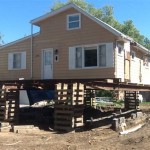Converting Crawl Space to Basement: Essential Aspects
Transforming a crawl space into a habitable basement can be a rewarding project that adds value and living space to your home. However, this conversion requires careful planning, skilled execution, and a thorough understanding of the essential aspects involved.
1. Feasibility Assessment
Before embarking on a crawl space conversion, assess its feasibility. Factors to consider include the height and accessibility of the crawl space, the presence of moisture or foundation issues, and any existing utilities or obstructions.
2. Building Codes and Permits
Ensure compliance with local building codes and regulations. Obtain the necessary construction permits and inspections to guarantee the safety and structural integrity of the converted basement.
3. Excavation and Foundation
Excavate the crawl space to the desired depth, making sure to maintain proper slope and drainage. Reinforce the foundation walls to support the additional load of the basement structure.
4. Waterproofing and Insulation
Install a comprehensive waterproofing system to prevent moisture penetration. This typically involves sealing exterior walls and floors with membranes or coatings, and installing a drainage system to manage water away from the basement.
5. Framing and Walls
Frame the basement walls, using studs and joists to create the structure. Install drywall or paneling to finish the walls and provide a clean, insulated surface.
6. Flooring and Ceiling
Install a subfloor and finish flooring of your choice. Consider using durable and moisture-resistant materials such as vinyl or engineered wood. For a finished look, add a ceiling with drop tiles, drywall, or other options.
7. Ventilation and Lighting
Provide adequate ventilation to prevent moisture buildup and maintain a comfortable environment. Install windows and vents, and consider a dehumidifier if necessary.
8. Electrical and Plumbing
Extend electrical and plumbing systems into the basement. Install light fixtures, outlets, and any required plumbing for a bathroom, kitchen, or other intended use.
9. Utilities
Ensure access to other essential utilities such as heating, cooling, and internet. Plan for ductwork or radiant heating, as well as cable or fiber optic connections.
10. Finishing Touches
Once the structural and utility aspects are complete, add finishing touches such as paint, trim, and built-ins. Consider the intended use of the space and incorporate design elements to create a functional and inviting basement.
Converting a crawl space to a basement is a significant undertaking that requires expertise and attention to detail. By carefully considering these essential aspects and involving qualified professionals, you can achieve a successful transformation that enhances your home's functionality and value.

Converting Crawl Space To Basement Good Or Bad Mellowpine

Castle Builds Crawl Space Basement Conversion Dig Out Services Denver

Crawl Space To Basement Denver Conversion Finishing

Crawlspaces 2 Basements Expertise Create Basement From Existing

How To Turn A Crawl Space Into Short Basement Studio Zerbey

Increase The Living Space Of Your House Bisson Expert

Converting Your Crawl Space Into A Storage Area Quick Guide Bob Vila

Turning A Crawl Space Into Basement Read This First

Crawlspace Conversion Atlas Restoration

Can You Convert A Crawl Space Into Basement







